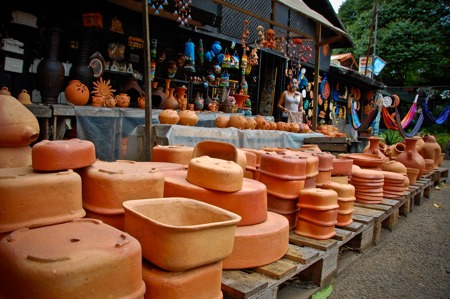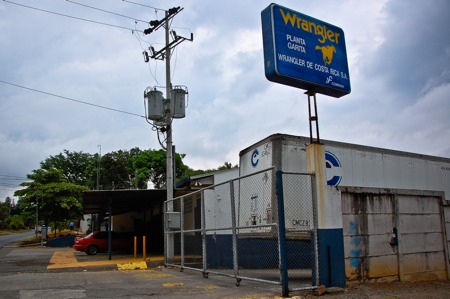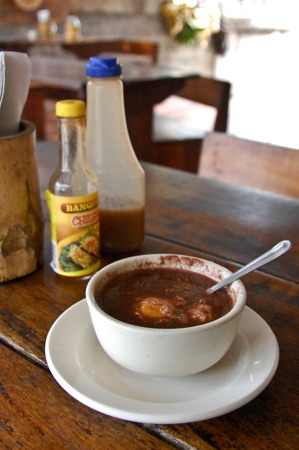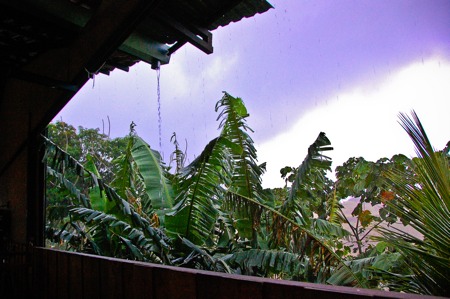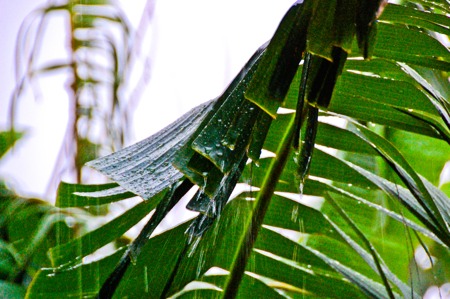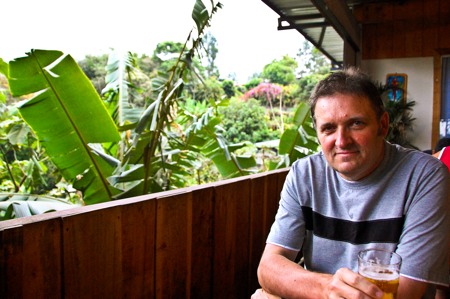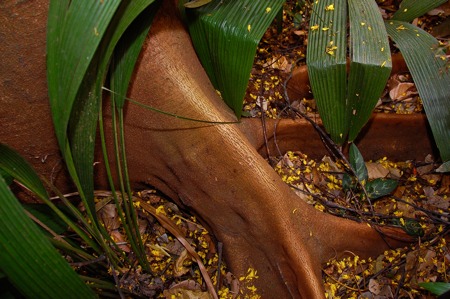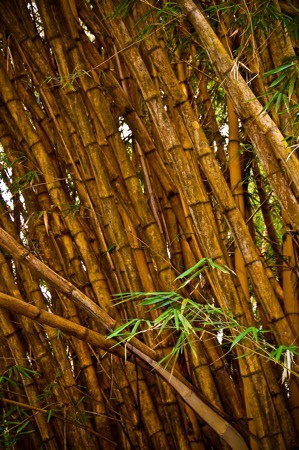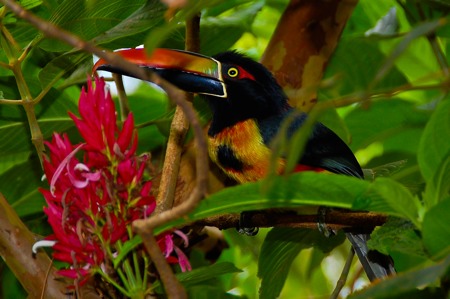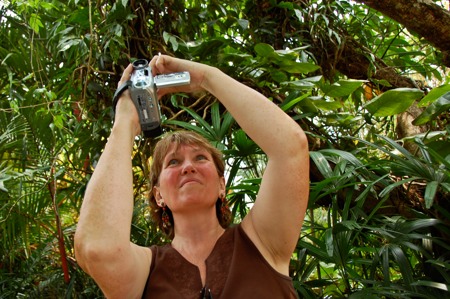by Anne Watcher on Wednesday February 20th, 2008 at 7:15am
This little shop is mingled in with all the sodas along the road heading into Alajuela. The unglazed pottery for sale was quite beautiful and is a local craft of Costa Rica. Some of it was painted but most was in it's raw state. Also for sale were hammocks which are perfect for that afternoon nap, if you can get in and out safely!!!
In the town of Guaitil on the Nicoya Peninsula the resident artisans fashion their pottery in the tradition of the Chorotega Indians, once an indigenous population that was later absorbed into the Costa Rican culture. The tradition of making hand-thrown pottery has been handed down from generation to generation for over 800 years.
The craft of the Chorotega pottery makers support their entire village and all family members learn the craft. Collecting the sand for the clays to make the pottery requires a rigorous journey by bus and foot to three different mountains, the finest sand being found at the opening of the iguana nests there. Three different colors of sand are used for the clays - tan, red ochre, and black. Black sand is the most difficult to obtain, so it is not always available. The sand is then mixed in large mortars with pestles to turn it into clay.
All of the pots are thrown completely by hand - no foot pedal or electricity used, only the skill of the potter's hands. Once the pot is formed, contrasting clays of either ochre or black are used to wash the outside of the unfired pots. Then intricate designs, said to have been power and fertility symbols of the Chorotega Indians, are carved into the surface of each piece. The pots are then fired in a wood burning, igloo-shaped, earthen kiln that can be seen in each artisan's yard.
If our travels take us to the northwest (about 8 hrs. by bus) we will post pictures of this beautiful art form. Rob would love to photograph the artisans at work.
by Anne Watcher on Wednesday February 20th, 2008 at 7:14am
Several U.S. companies like Intel (large complex just outside Alajuela), Conair, subsidiaries of Lee and Wrangler jeans, and Rawlings Sporting Goods, which makes major league baseballs in Costa Rica - have manufacturing plants here in Costa Rica.
This is a picture of the La Garita Wrangler factory located on Hwy.3 between the Interamerican Hwy. and Zoo Ave. Due to it's location , you will see many Ticos and Ticas wearing Wranglers as they are sold quite inexpensively here in Costa Rica.
by Anne Watcher on Tuesday February 19th, 2008 at 2:08pm
This is found on most menus where local cuisine is served. It is quite flavourful but I do think you have to like the taste of cilantro to really enjoy it. My other recommendation would be to have the egg hardboiled and then add it to the soup although this may not be authentic. Enjoy!!!
Black Bean Soup (Sopa de Frijoles Negros)INGREDIENTS:
1 pound black beans1 tablespoon of cooking oil1/2 cup of diced onion2 cloves of garlic (chopped)1 chopped green or red bell pepper1/2 cup chopped celery1/2 cup fresh cilantro (use fresh only!)Salt and pepperMETHOD:
Cover beans with water and soak overnightCook with at least 7 cups of water for 3 hoursAdd more water if neededWhen almost soft add 1 tablespoon of cooking oil, 1/2 cup of diced onion, 2 cloves of garlic (chopped), 1 chopped green or red bell pepper, 1/2 cup chopped celery, 1/2 cup fresh cilantro (use fresh only!),Salt and pepperRecommendations for serving:
Add fresh lemon juice, Tabasco, sour cream, chives, or green onions, or add one or two eggs, cook for another 2-3 minutes, serve with wheat flour or corn tortillas.
by Anne Watcher on Tuesday February 19th, 2008 at 6:55am
Well it sure doesn't rain often in the dry season but when it does it pours! Rob and I had taken the bus to Zoo Ave and decided to walk part of the way back to Norma's ( about 3km of the 8km trip). I wanted to stroll through Vivero Central-largest plant distributor in CR-on the way home. It had turned cloudy and you could feel a slight humidity in the air (first I had felt) so we were keeping an eye on the weather also. When we got to the vivero, Rob had to make a "pit stop" so we went into the restaurant and had an Imperial and used the facilities.
We sat by the open air windows over-looking the gorge below. It was a nice view and we could see the storm moving in and listen to the thunder getting closer. The temperature took a definite drop and then the clouds opened up and it POURED, straight down, no wind. You can imagine the sound as the restaurant had a steel roof (with one major leak) and no windows to block out the roar of the rain. It was awesome!!!! We are so glad we stopped and of course had to wait till it eased to go wait for the bus so had time for a second Imperial. Check out video section for more sights and sounds of our first rain here in Costa Rica ( http://asifweknow.com/index.php?pg=5&vid=6 ) .
Costs: Imperials c800 each View and Sound Effects: PRICELESS
View from the table
The rain soured tree outside the window
Rob relaxing
by Anne Watcher on Tuesday February 19th, 2008 at 6:47am
I had read in the travel books about Zoo Ave just off the Interamerican Hwy. about 3 kms. You take the La Garita-Alajuela turn-off when coming from San Jose. It is by and large a breeding centre for endangered spieces and a rehabilitation centre for abused and injured animals. It also has a large zoo section and is one of only two zoos in the world that have a Quetzal. I had read that is was both a "must see" and by others disappointing. So Rob and I went on Monday to check it out.
It was a nice way to spend an hour or two but I do think the entrance fee of $15.00 pp is a little high. Locals and children do get in for much less. There are endless variety of birds, lots of turtles and few large cats and the Quetzal. When we were there they (the quetzals) were at the back of the cage so could hardly see them. The cages are large with lots of local fauna and water which is good for the animals but made is hard to see some of the animals as they could be way at the back of their area. It is well maintained however and everything looked well cared for. Signs describing both animals and plants were both in English and Spanish. There is a short video presentation also that explains their rehabilitation work. The goal is to breed national species for reintroduction into the wild. The zoo has successfully bred the scarlet macaw, green macaw, curassow, guan, and about 50 other native bird species with the help of a human-infant incubator. The breeding center is off-limits however.
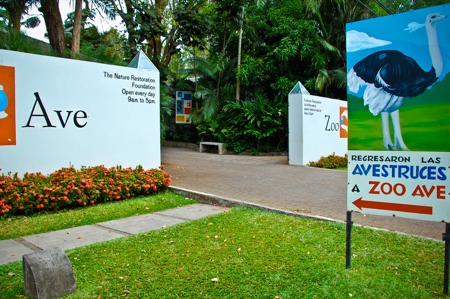
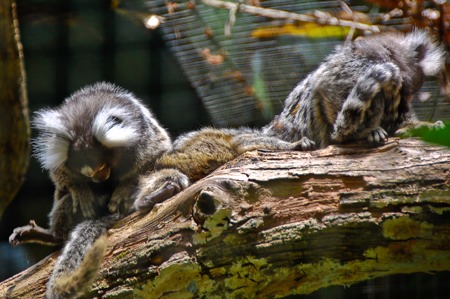
Forgot their name-but local to Costa Rice and cute
Roots looked like iron
Bamboo Trees - huge
Fiery-billed Aracari
Not sure what breed this is
--------------------------------
Meow of the female Mountain Lion
[mp3:mp3/meow.mp3]
